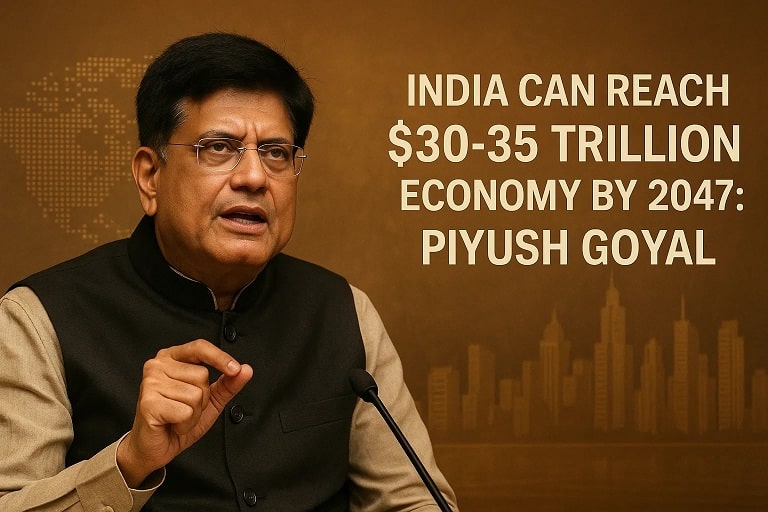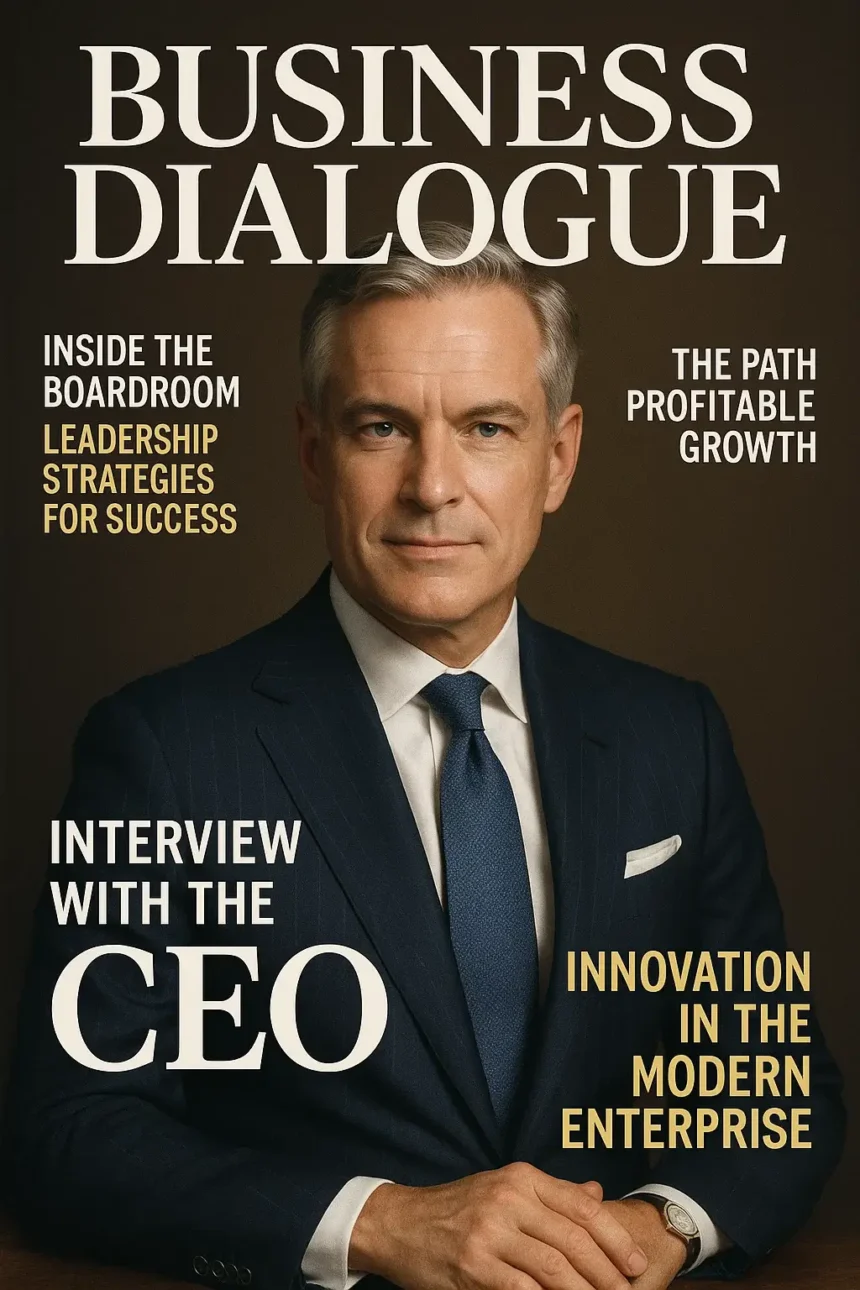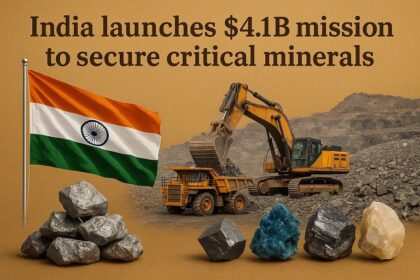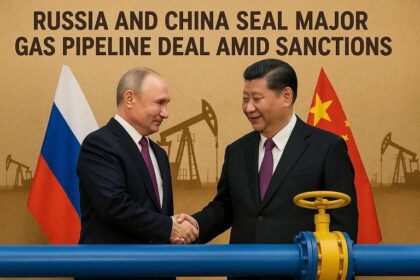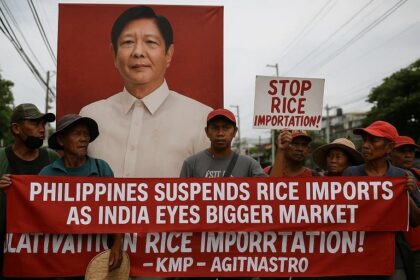India Can Reach $30-35 Trillion Economy by 2047: Piyush Goyal’s Vision for Viksit Bharat
Commerce and Industry Minister Piyush Goyal has reiterated India’s ambitious trajectory to become a $30-35 trillion economy by 2047, positioning the nation as a fully developed powerhouse amid rapid infrastructure growth and technological advancements. Speaking at the Global Fintech Fest 2025 in Mumbai on October 7, 2025, Goyal emphasized that “no power on earth can stop India from becoming a developed nation by 2047,” highlighting the role of macroeconomic stability, GST reforms, and global trade resilience. This projection, aligning with Prime Minister Narendra Modi’s Viksit Bharat@2047 vision, underscores India’s current status as the world’s fourth-largest economy at $4 trillion and its potential to triple in size over the next two decades. As India navigates global challenges like U.S. tariffs, Goyal’s optimistic outlook inspires stakeholders to contribute to this transformative journey. This in-depth analysis covers the minister’s statement, latest developments, historical context, economic impacts, future scopes, and more, providing a roadmap to India’s economic ascent.
Why Piyush Goyal’s $30-35 Trillion Projection Resonates
Goyal’s forecast is grounded in India’s robust growth fundamentals, including a 7-8% annual GDP expansion, digital infrastructure like UPI, and initiatives such as Production-Linked Incentives (PLI). Achieving $30-35 trillion by 2047 would require sustaining 8-10% growth, leveraging demographics (1.4 billion population with a young workforce), and addressing challenges like inequality and climate resilience. This vision not only boosts investor confidence but also aligns with global shifts, positioning India as a counterweight to slowing Western economies and China’s slowdown. For citizens, it promises enhanced living standards, job creation, and global influence, making every individual’s contribution pivotal to the Viksit Bharat goal.
Key Pillars Supporting the $30-35 Trillion Target
- Infrastructure Surge: $1.4 trillion investment by 2025 in roads, ports, and digital networks.
- Fintech and Digital Economy: UPI’s 15 billion monthly transactions driving 10% of GDP.
- Trade and Exports: Targeting $2 trillion exports by 2030 through FTAs and PLI schemes.
- Sustainability Focus: Green energy and circular economy to ensure inclusive growth.
Latest Events and News on Goyal’s Economic Vision
Global Fintech Fest Address on October 7, 2025
At the Global Fintech Fest 2025, Goyal outlined India’s path to developed nation status, stating the $30-35 trillion economy is “well within reach” through rapid infrastructure and tech adoption. He positioned AI as India’s “next Y2K moment,” urging fintech leaders to build trust as the nation’s “strongest currency.”
Press Interactions and Policy Announcements (September-October 2025)
On September 8, 2025, Goyal hailed India’s resilience to global challenges, projecting the $30 trillion milestone by 2047 while crediting GST reforms for economic momentum. In April 2025, during a PIB briefing, he called for citizen participation in Viksit Bharat, emphasizing the leap from $4 trillion to $30-35 trillion.
Market and Expert Reactions
Post-October 7 remarks, Sensex gained 200 points on October 8, 2025, reflecting optimism. Analysts at CNBC-TV18 and Devdiscourse echoed Goyal’s confidence, noting infrastructure and trade as key enablers.
India’s Economic Transformation
India’s economy has evolved from a $300 billion GDP in 1991—post-liberalization crisis—to $4 trillion today, driven by IT exports, manufacturing push, and digital inclusion. The 1991 reforms dismantled the License Raj, sparking 6-7% growth in the 2000s. Modi’s 2014 agenda accelerated this with GST (2017) and Make in India (2014), propelling India to the fifth-largest economy by 2020. Goyal’s 2047 vision builds on the Atmanirbhar Bharat (2020) and Viksit Bharat (2023) blueprints, aiming to surpass Japan and Germany.
Timeline of India’s GDP Milestones
| Year | GDP (USD Trillion) | Key Driver |
|---|---|---|
| 1991 | 0.3 | Liberalization reforms. |
| 2008 | 1.2 | Global IT boom. |
| 2020 | 2.7 | Digital economy surge. |
| 2025 | 4.0 | Infrastructure investments. |
| 2047 (Projected) | 30-35 | Viksit Bharat initiatives. |
Impacts of the $30-35 Trillion Economy Goal
Economic Growth and Job Creation
Sustaining 8% growth could create 500 million jobs by 2047, reducing unemployment to under 3%. Sectors like manufacturing (25% GDP share) and services will drive $10 trillion in exports.
Social Inclusion and Inequality Reduction
Per capita income could rise from $2,800 to $20,000, lifting 200 million out of poverty through skilling and healthcare investments.
Global Influence and Sustainability
India would become the third-largest economy, leading in green tech and AI, with carbon-neutral goals enhancing its soft power.
Challenges Ahead
Inflation control, skill gaps, and geopolitical risks like U.S. tariffs could hinder progress without adaptive policies.
Future Scopes: Pathways to Viksit Bharat 2047
Sectoral Transformations
By 2030, digital economy to contribute 25% of GDP; renewables 50% of energy mix by 2040.
Policy and Investment Focus
$10 trillion infrastructure spend by 2047, with PLI extensions attracting $5 trillion FDI.
Inclusive Development
Universal skilling programs for 1 billion youth, ensuring equitable growth across states.
Potential Scenarios for 2047
- Optimistic: $35 trillion via 9% growth; global innovation hub.
- Moderate: $30 trillion at 7.5% CAGR; balanced development.
- Pessimistic: $25 trillion if external shocks persist.
Frequently Asked Questions (FAQs)
What did Piyush Goyal say about India’s economy by 2047?
Goyal projected a $30-35 trillion economy, achievable through infrastructure, tech, and citizen contributions.
When and where did Goyal make this statement?
At Global Fintech Fest 2025 in Mumbai on October 7, 2025.
How does India plan to achieve this growth?
Via GST reforms, PLI schemes, digital fintech, and $1.4 trillion infrastructure push.
What is Viksit Bharat 2047?
Prime Minister Modi’s vision for a developed India by its 100th independence year, focusing on prosperity and sustainability.
What challenges could derail this target?
Geopolitical tensions, skill shortages, and climate risks, but Goyal stresses resilience.
How will this impact citizens?
Higher incomes, more jobs, and better living standards for 1.4 billion people.
India’s $30-35 Trillion Horizon: A Shared Destiny
Piyush Goyal’s vision of a $30-35 trillion economy by 2047 encapsulates India’s unstoppable rise, fueled by innovation and collective effort. As Viksit Bharat unfolds, every citizen’s role will shape this prosperous future.
Key Takeaways
- Ambitious Target: $30-35T by 2047, from $4T today.
- Growth Drivers: Infrastructure, fintech, and reforms.
- Inclusive Call: Citizens key to developed nation status.
- Global Edge: Resilience amid challenges.

